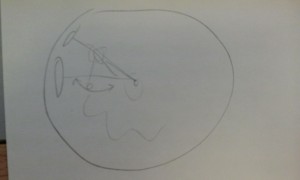For our project we plan on making a machine that will draw a line based on audio input. Here are our sketches of what we though this might look like:

Jon’s original idea of what our machine could look like.
Our machine would move forward at a constant speed. A piece of chalk or a pen attached to a movable arm would draw a line on the ground. An attached microphone would receive notes or tones from the user. The audio would then be converted into data, through Pure Data or Processing. That data would be used to set the speed the drawing arm moves back and forth. When turned on and given an audio input, the machine would draw a long curved line along the ground, based on the input. This idea had a problem though, since it would be difficult to attach a computer to something that could move more than a couple feet. Since we only have a week to make this project we had to simplify things and remove the mobile aspect altogether.
Here is a rough sketch of what we are doing now:

A quick sketch of what our project will be like.
Rather than having a moving vehicle, we will instead have a stationary rotating device which will draw out the audio input in lines in circles as it goes around the drawing surface. This eliminates the mobility problem, and even adds to the visual interest. Rather than drawing a single long line in one direction, the line would continuously overlap itself, perhaps creating an image reminiscent of a Spirograph.
We will have to research how motors work, and how their speed can be changed so that they can suit the purposes of our project. We will work with an arduino to build this, so some research on how to use the arduino will be useful. We also need to see how arduino can interface with pure data or processing. We also need to convert audio input into numbers so that the motor can turn the pen/chalk at the correct speed.
For supplies we have an arduino, various electrical components like resistors and LEDs, and we may use legos to build the frame. We may have to purchase two motors as well, one for spinning the drawing utensil, and the other to make the chalk/pen draw.



















